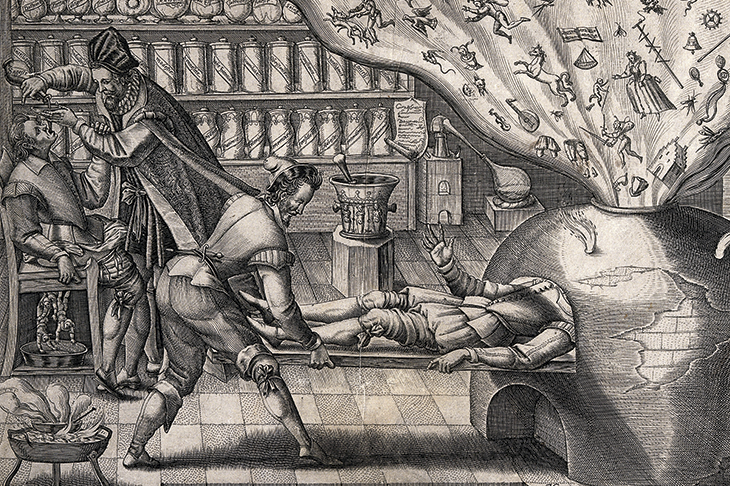Footling around on the internet recently, I stumbled on a clip of a young woman singing Leonard Cohen’s ‘Hallelujah’ to a full-grown cow. As she sat cross-legged, strumming away not very well on a guitar, the cow lay down beside her and gently nudged her with its huge head as adoringly as any puppy. The sight brought to mind a passage in Robert Burton’s The Anatomy of Melancholy in which he reflects on music as a remedy:
‘Harts, hinds, horses, dogs, bears are exceedingly delighted with it; elephants, Agrippa adds; and in Lydia in the midst of a lake there be certain floating islands (if ye will believe it), that after music will dance.’
Wonderful craziness like this, which accommodates both the plausible and the beyond-belief in a spirit of generosity and delight, is characteristic of Burton’s great work; and it may go a little way to answering the question of why one should bother with a 400-year-old text about some of the darkest corners of human experience. It is framed in an understanding of medicine and the human body that has long since been debunked — and at half a million words, and more than 500 pages, is, even in paperback, so heavy as to be almost unpickupable.
You don’t have to take my word for it. The Anatomy is widely acclaimed as a classic. Laurence Sterne stole chunks from it for The Life and Opinions of Tristram Shandy, Gentleman. Samuel Johnson said it was the only book that got him out of bed early just to read it. Keats adored it. Borges’s Library of Babel is prefaced with lines from it. Samuel Beckett was a fan, and Anthony Burgess thought it one of the great comic works of the world. Welcoming the paperback edition in 2001, the critic Nick Lezard called it the best book ever written and the book to end all books. More recently, the publisher John Mitchell described it as some of the greatest prose from the greatest era of English prose.
The question of why read The Anatomy of Melancholy may be easier to answer than the question of how. In A User’s Guide, Mary Ann Lund offers a lucid and systematic approach to the how. A scholar of Renaissance literature, Lund is deeply versed in the age in which Burton lived. Echoing the structure of Burton’s own book, her Guide is divided into three sections — on Causes, Symptoms and Cures of Melancholy — so that the whole (Sorrow and Fear, Body and Mind, The Supernatural, Delusions, Love and Sex, Despair, The Non-Naturals, Medicine and Surgery, Lifting the Spirits) becomes more manageable. Lund sets out the facts of Burton’s life, traces the sources of the huge variety of material upon which he drew, and outlines with clarity how the theory of the four humors shaped how he and his contemporaries conceived human life and fate.
One of the things that comes across vividly is just how wrong the humoral theory was which early modern Europeans had inherited almost unchanged from antiquity, and how alien it is to our understanding today. But, as Lund wisely observes, while the system does not describe the body as we know it functions, it ‘does a remarkable job of describing the body as we experience it’. The physiology on which Burton relied may be ludicrous (if ingenious), but as a psychologist Burton is our brilliant contemporary. Lund is also alive to his ‘seriousness of social purpose’, citing his observations on the ‘heart-eating melancholy’ of the enslaved and the poor, ‘preyed upon by polling officers for breaking the laws, by their tyrannizing landlords, so flayed and fleeced by perpetual exactions that… they cannot live’.
At a time when challenges to mental health are severe and widespread, Mary Ann Lund is a welcome guide to a classic work on the subject. Among Burton’s great virtues is what the novelist Philip Pullman calls his ‘great, broad, humane sympathy’. Burton could also be wonderfully inventive and exuberant — aspects reflected in Amy Liptrot’s recent series for British radio, A New Anatomy of Melancholy. These are qualities to hold close, even when one is solitary and idle, and watching a woman play a guitar to a cow.
This article was originally published in The Spectator’s UK magazine. Subscribe to the US edition here.


















